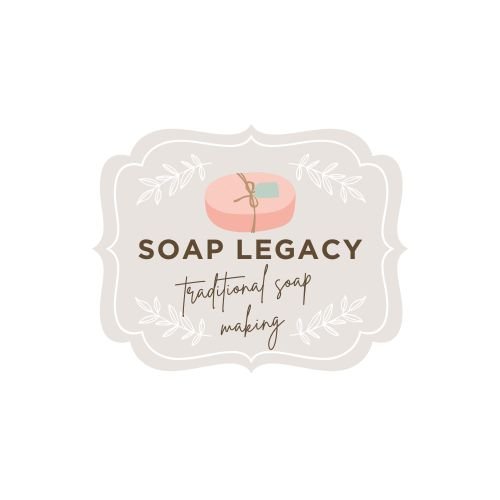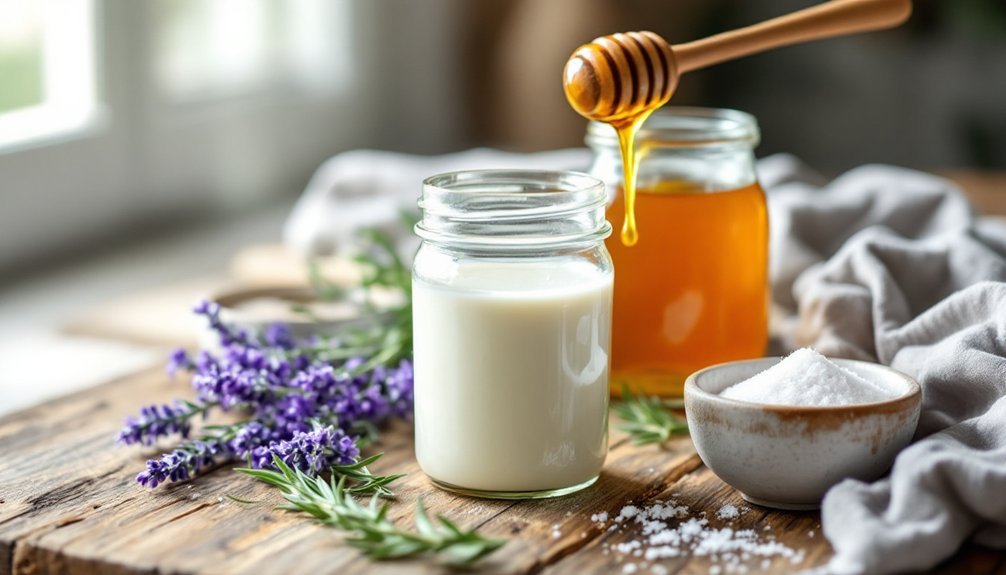Making soap with basic farmhouse ingredients gives you control over what touches your skin while saving money. You'll transform simple items like rendered fats, essential oils, and garden herbs into luxurious, chemical-free cleansers that moisturize better than commercial alternatives. The process connects you to traditional skills passed through generations, while creating customized bars with therapeutic benefits from ingredients you trust. Discover how your kitchen waste and farm resources can become premium skincare products with just a few simple steps.
The Lost Art of Traditional Soap Crafting

While modern consumers typically grab soap from store shelves without a second thought, traditional soap crafting once represented an essential homestead skill passed through generations.
This time-honored process relied on simple ingredients: rendered animal fats from butchering combined with lye made from wood ash.
You'd find our ancestors dedicating entire days to soap making, patiently stirring mixtures over open fires while following practices often guided by moon phases and tides.
They transformed kitchen waste like cooking grease into valuable cleaning products, demonstrating remarkable resourcefulness. This process is similar to modern hot process soap, where saponification is completed during the cooking phase rather than during a curing period.
Colonial recipes varied but typically included tallow or lard, homemade lye, and sometimes additions like rosin for hardness.
This practical knowledge that sustained homesteads for centuries has largely disappeared from today's homes, replaced by commercial alternatives.
From Farm to Bathroom: The Beauty of Simplicity
You'll find remarkable simplicity in creating personal care products with ingredients already available in your pantry or local farm.
This back-to-basics approach to skincare isn't just about cutting costs—it's about reclaiming control over what touches your skin while enjoying luxury without synthetic additives.
When you transform humble farm ingredients like goat's milk, olive oil, and oatmeal into handcrafted soap, you're participating in a self-sufficiency revolution that connects you directly to centuries-old traditions. Incorporating colloidal oatmeal into your soap provides proven benefits, including soothing dry, itchy skin while acting as a powerful emollient.
Back-To-Basics Skincare Revolution
As consumer preferences shift dramatically toward natural alternatives, a back-to-basics skincare revolution has taken hold across bathrooms nationwide.
You're part of the 59% who increasingly value simple, natural formulations over complex commercial products.
This minimalist approach isn't just trendy—it's rooted in growing skepticism about over-complicated routines.
You'll find that farmhouse soap-making aligns perfectly with the "less is more" philosophy dominating today's skincare landscape.
By crafting soaps with recognizable ingredients from your kitchen or garden, you're embracing what modern consumers seek: transparency, sustainability, and efficacy. The growing interest in ingredients you can pronounce reflects the fact that 52% of consumers actively seek products with recognizable ingredients.
This revolution represents more than just skincare—it's part of a holistic wellness movement where what you put on your body matters as much as what goes in it.
Self-Sufficiency Meets Luxury
In today's fast-paced world, transforming humble farm ingredients into luxurious soap represents the ultimate paradox of modern self-sufficiency. You're creating something truly opulent from the simplest materials around you.
With ingredients like lard from your own livestock, milk from your goats, and herbs from your garden, you're crafting a premium product that rivals expensive commercial brands. The luxury isn't just in the final product—it's in knowing exactly what touches your skin.
This balance of practicality and indulgence perfectly embodies modern homesteading. You'll save money long-term while using superior ingredients that commercial manufacturers often replace with synthetic alternatives. Your homemade soaps retain beneficial glycerin naturally produced during the saponification process, unlike commercial soaps where it's typically extracted for use in other products.
Each bar you create contains your personal touch, from custom scent blends to carefully selected moisturizing oils—connecting you to traditional craftsmanship while meeting contemporary desires for clean, transparent skincare.
Essential Farmhouse Ingredients for Quality Soap

Farmhouse soap making relies on ingredients found naturally in rural environments, creating products that are both authentic and beneficial for skin care.
Plant-based oils like coconut, palm, and olive form the foundation of quality soap, providing essential moisturizing properties. You'll also need distilled water as a clean base. For a truly authentic experience, consider organic plants which create creamy, luxurious lather similar to commercial products but without harsh chemicals.
For fragrance and skin benefits, add lavender or tea tree essential oils rather than synthetic perfumes. Natural colorants such as clays, teas, and herbal infusions give your soap visual appeal without chemicals.
Traditional animal fats like lard or tallow offer economical alternatives that homesteaders often have on hand.
These ingredients not only create superior soap but also support self-sufficiency and reduce your environmental impact through local sourcing and biodegradable materials.
The Science Behind Lard-Based Soap Recipes
Understanding the science behind lard-based soap requires knowledge of both chemistry and practical technique.
Lard contains oleic (46%), palmitic (28%), and stearic (13%) fatty acids that create highly moisturizing soap when combined with lye through saponification.
You'll need precise measurements – the lye-to-lard ratio is critical for producing safe, effective soap.
When mixing, maintain both solutions between 25°C and 51°C for ideal blending.
Watch for "trace" – the point when your mixture begins to thicken.
Lard soap provides creamy lather and exceptional moisturizing properties because it retains glycerin that commercial manufacturers typically remove.
For better cleansing power, consider adding coconut oil, while castor oil enhances bubbliness.
During curing (4-6 weeks), excess water evaporates and saponification completes, resulting in a mild, conditioning bar ideal for sensitive skin.
The historical use of animal fats for soap making represents a sustainable practice that reduces household waste while creating an effective cleansing product.
Transforming Animal Fats Into Luxurious Cleansers

While commercial soap manufacturers typically use refined ingredients, transforming farm-sourced animal fats into luxurious cleansers creates uniquely superior products with remarkable skin benefits.
You'll find beef tallow, pork lard, and lamb fat create harder, more durable bars that last longer than their commercial counterparts.
The rendering process is straightforward: slowly melt your animal fat, strain out impurities, boil with water, refrigerate, and then dry the hardened fat.
This frugal approach minimizes waste while maximizing your farm resources.
When making soap, combine your rendered fat with lye solution at the proper temperature, add essential oils for fragrance, and then pour into molds.
After curing for several weeks, you'll have created a sustainable, cost-effective alternative that fully utilizes what would otherwise be discarded. This traditional craft allows a family of four to produce enough soap for an entire year from extra animal fat.
Customizing Your Homestead Soap With Garden Herbs
Beyond rendering animal fats, the true magic of farmhouse soap-making emerges when you incorporate herbs from your own garden. Lavender adds calming properties, while calendula maintains its vibrant color throughout the curing process.
These garden-grown additions provide therapeutic benefits while keeping your skin safe from commercial irritants. You'll appreciate the control over every ingredient, allowing you to tailor soaps to specific needs. Most herbs prefer poor to well-drained soil for optimal growth in pots or garden beds.
From garden to soap dish—pure ingredients, personalized care, and peace of mind with every wash.
Try combining rosemary with cornmeal for a natural exfoliant, or create marbled effects with powdered mint leaves. Most soap herbs thrive in sunny conditions and can be grown year-round in pots, even with limited space.
For a special touch, consider themed combinations like a "gardener's soap" with dill and basil, or top your creations with rose petals for gift-worthy presentation.
Cost Benefits of Using On-Hand Farm Resources

Transforming readily available farm resources into soap offers substantial financial advantages beyond the creative satisfaction. When you render tallow from your own livestock or utilize leftover cooking fats, you'll dramatically reduce costs compared to purchasing specialty oils or finished artisanal soaps.
You'll find that repurposing household items as molds eliminates the need for specialized equipment, while sourcing lye locally cuts shipping expenses. This farm-to-soap approach creates products that appeal to customers seeking environmentally friendly options, potentially commanding premium prices despite lower production costs. With typical startup costs ranging from $1,600 to $3,900 for a homemade soap business, utilizing farmhouse ingredients significantly lowers your initial investment.
Your operational efficiency improves when ingredients are just steps away, saving procurement time and allowing quick experimentation with new formulations.
Most importantly, you're creating sustainability through self-sufficiency while producing authentic goods that today's conscious consumers increasingly value.
Step-by-Step Basic Farmhouse Soap Method
You'll need to gather your essential supplies first, including a stainless steel pot, thermometer, and protective gear before handling any ingredients.
Always prioritize lye safety by wearing goggles and gloves, mixing in a well-ventilated area, and adding lye to water (never the reverse).
For precision and successful soap batches, make sure to measure all ingredients by weight using scales rather than volume measurements.
After pouring your soap into molds, you must allow it to cure for 4-6 weeks before use, giving time for the saponification process to complete and excess moisture to evaporate.
Gather Essential Supplies
Before diving into the soap-making process, gathering all necessary supplies guarantees a smooth and uninterrupted experience.
You'll need accurate measuring tools and appropriate safety gear to handle ingredients safely, especially lye.
- Measuring equipment: A digital scale for precise ingredient measurements and a thermometer to monitor temperatures when mixing lye and oils.
- Mixing tools: Stainless steel utensils that won't react with lye and an immersion blender for achieving uniform consistency.
- Safety gear: Gloves and goggles to protect yourself from potential chemical splashes.
- Molds and containers: Silicone or plastic molds for shaping your soap, plus stainless steel containers for mixing.
Having everything ready before you begin will prevent frustrating interruptions and guarantee your farmhouse soap turns out perfectly every time. You should also cover your workspace with newspaper or other protective covering to shield countertops from potential spills.
Lye Safety Matters
With all your supplies gathered, let's focus on the most important safety aspect of soap making: working with lye. This caustic substance demands respect – it can cause serious burns and emit harmful fumes.
Always wear protective gear (gloves and goggles) when handling lye. Work in a well-ventilated area with proper lighting and keep distractions away. Use only 100% sodium hydroxide and add it to water – never the reverse. Sprinkle it slowly while stirring gently to guarantee complete dissolution. Place your container in the sink when mixing to contain any potential lye water spills.
For equipment, stick with glass, stainless steel, or heat-resistant plastic containers. Avoid aluminum or tin as they react with lye. Confirm your mixing containers have adequate space to prevent splashing.
When stored properly and used correctly, lye transforms into safe, wonderful soap through the saponification process.
Cure Before Use
The most essential step in your soap-making journey happens after the bars are molded: curing. This 4-6 week process completes saponification, evaporates excess water, and transforms your creation into a milder, harder, longer-lasting bar.
Don't rush this critical phase—properly cured soap will reward you with superior lather and skin-safe results.
Create ideal curing conditions by:
- Placing bars in a well-ventilated area away from direct sunlight
- Confirming adequate airflow between bars (stack carefully if needed)
- Monitoring weight loss to determine when curing is complete
- Avoiding premature packaging that traps moisture
While innovative rapid curing methods exist, traditional farmhouse soap benefits from patience. Using a wire rack provides optimal airflow around your soap bars during the curing process.
Your diligence during this waiting period guarantees your handcrafted bars will be gentle, effective, and market-ready.
Seasonal Variations for Year-Round Soap Making
Adapting your soap recipes to reflect the changing seasons creates not only functional products but also meaningful connections to the natural world around you.
Each season offers unique ingredients that benefit your skin differently throughout the year.
Nature gifts us seasonal ingredients that address our skin's changing needs with perfect timing.
In spring, incorporate dried flower petals and fresh herbal infusions like nettle.
Summer calls for cooling menthol, citrus scents, and aloe vera to soothe sun-exposed skin.
When autumn arrives, embrace pumpkin puree, warm spices, and apple cider fragrances with rich orange and red hues.
Winter soaps benefit from increased shea butter content and evergreen scents to combat dryness.
Year-round staples like coconut oil, olive oil, and versatile essential oils like lavender provide a consistent foundation for your seasonal creations, allowing you to craft relevant soaps regardless of the calendar. Remember that proper curing time of 4-6 weeks is essential for all seasonal variations to develop good lather and longevity.
Storing and Aging Your Handcrafted Farmhouse Soap

Properly storing and aging your handcrafted farmhouse soap transforms a good bar into an exceptional one, much like how fine wine develops character over time.
Your soap needs proper airflow and climate control to reach its full capability.
For prime results, follow these essentials:
- Create a curing station in a cool, well-ventilated area away from direct sunlight to preserve colors and fragrances.
- Use breathable storage like cardboard boxes or wooden racks instead of sealed containers that trap moisture.
- Maintain low humidity with fans or dehumidifiers to prevent glycerin dew and extend shelf life.
- Store finished soap on draining dishes and turn bars occasionally to guarantee even drying.
Many commercial soaps lack the natural glycerin that handmade soap retains, which is why proper storage is especially important to preserve this moisturizing element.
Your patience will be rewarded with harder, longer-lasting bars with improved lather.
Frequently Asked Questions
How Long Does Homemade Lard Soap Typically Last?
Your homemade lard soap can last 6-12 months for daily use or 1-3 years when properly stored. You'll get more longevity by curing it longer and keeping it in cool, dry conditions.
Can I Make Soap Without Lye?
No, you can't make soap without lye in some form. You can use melt-and-pour bases to avoid handling lye yourself, but these bases were already made with lye during manufacturing.
Are Animal-Based Soaps Ethical Compared to Vegetable Alternatives?
Animal-based soaps raise ethical concerns about animal exploitation and environmental impact. You'll find vegetable alternatives more aligned with cruelty-free values, sustainability goals, and they're often gentler on your skin while supporting conscious manufacturing practices.
How Do Different Water Sources Affect Soap Quality?
Your soap's quality changes dramatically with water source. Hard water creates scum and reduces lather, while soft or distilled water enhances bubbles and consistency. You'll get better results using distilled water for soap-making.
Can Homemade Soap Be Safely Used for Laundry?
You can use homemade soap for laundry, but be cautious with ingredients like borax and lye. It's less effective in hard water, may leave residue, and isn't ideal for all fabrics or washing machines.
In Summary
By crafting soap with basic farmhouse ingredients, you're not just making a cleanser—you're reclaiming a heritage skill. You'll save money, avoid harsh chemicals, and create something truly personal. Whether you're using lard from your own animals or herbs from your garden, you're participating in a sustainable tradition. Give it a try, and you'll soon appreciate why simple, farm-sourced soap has endured for generations.





Leave a Reply